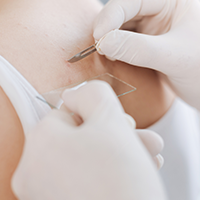Becoming a Dermatologist
Accreditation & Training Positions
ACD accredits training positions in dermatology and in Mohs surgery.
Training positions are accredited in order to:
- Ensure that all trainees/ candidates are provided with a learning environment which will educate and train competent dermatologists, as defined by the ACD curriculum, and/or competent Mohs specialists as defined by the Mohs surgery curriculum.
- Maintain a consistent level of education and training in every accredited post.
- Gather feedback from key stakeholders to continually improve all aspects of the training programs
- Expand all
- Collapse all
All Training Positions are accredited in accordance with defined Standards and College regards these as important for the quality education and training of Trainees/Candidates.
All documentation in relation to the Standards, accreditation outcomes, applying and the application process can be found here:
| Document | Dermatology Training Positions | MOHs Training Positions |
|---|---|---|
| Accreditation Process | Download | Download |
| Guidelines/Standards | Updated standard | Download |
| Application | APPLY Online | APPLY Online |
| Accreditation Timetable | Download Registrar Timetable Download Training Faculty Network timetable | Timetable Template |
| Candidate Feedback Form | N/A | Download |
| Sample Accreditation Report | Download | Download |
The Accreditation Committee accredit College Training Positions according to a State-based five-yearly cycle.
The current timetable for the College’s State Training Structure Accreditation is as follows:
Unscheduled state training structure accreditation
Unscheduled state training structure accreditation Unscheduled state training structure accreditations may also be carried out for the following reasons:
| 2020 | South Australian State Training Structure (includes Northern Territory) |
| 2021 | Queensland State Training Structure |
| 2022 | New South Wales State Training Structure (includes Australian Capital Territory) |
| 2023 | Victorian State Training Structure (includes Tasmania) |
| 2024 | Western Australia State Training Structure |
- If the College is advised that there have been significant changes to the structure or function of any particular training position, an accreditation site visit or review may be conducted in advance of the usual cycle.
- If a complaint from a Fellow or trainee/candidate is received, this will generate a review, and/or a visit to that training position/s.
The Australasian College of Dermatologists has a number of accredited dermatology training positions and MOHs surgery training positions. The training positions are located both in Australia and overseas in the following Public Hospitals, Private Hospitals, Skin Health Institute and Private Practices, which all contribute to creating high standard Training Facility Networks:
| STATE | TYPE | LOCATION |
|---|---|---|
| Queensland | Dermatology |
|
| Mohs |
|
|
| New South Wales | Dermatology |
|
| Mohs |
|
|
| ACT | Dermatology |
|
| Victoria | Dermatology |
|
| Mohs |
|
|
| Northern Territory | Dermatology |
|
| South Australia | Dermatology |
|
| Western Australia | Dermatology |
|
| Mohs |
|
|
| Overseas Positions | Dermatology |
|
The Specialist Training Program (STP) is a Federal Government initiative to increase the number of training posts available for specialists-in-training outside traditional public teaching hospitals, providing an annual salary of $108,000 per post. An additional $25,000 per annum pro rata of rural loading is also available for posts with rotations to training sites located in areas classified under the Australian Standard Geographical Classification-Remoteness Area (ASGC-RA) as RA2-5.
The College administer 33 STP positions and 1 IRTP. All positions are accredited as per the College’s National Accreditation Standards.
STP funding is determined via application rounds by the Department of Health with assessment by the Department, the relevant specialist colleges and state/territory health jurisdictions. Only training facilities are eligible to apply for funding. There are no further application rounds scheduled at this time.
The training positions are to be in health care settings beyond traditional public teaching hospitals that include:
- Private hospitals
- Specialists’ rooms
- Clinics and day surgeries
- Aboriginal Community Controlled Health Service (ACCHS)
- Publicly funded health care facilities such as regional, rural and community health settings classified RA2-5
- Non-clinical settings (such as simulated learning environments)
- Increase the capacity within the health workforce to train Dermatologists
- Better train specialists in dermatology, with education that matches the nature of demand and reflect the way health services are delivered
- Increase the College’s capacity to make strategic decisions that increase trainees and specialist International Medical Graduates’ access to appropriate training and maximising their workforce contribution
- Develop networked specialist training arrangements
Additional funding is available for successful post if rotations include private setting via the Private Infrastructure and Clinical Supervision (PICS) funds. Up to $30,000 per annum is available for clinical supervision and private infrastructure.
For more information on the background of STP, view the STP Operational Framework on the Department’s website. Go to website
The College aims to ensure that all its official processes are conducted in a fair and transparent manner. Nevertheless, it is recognised that there is always the potential for grievances to arise and it is for this reason that the Reconsideration, Review and Appeals policy and procedures have been established.
Reconsideration, review and appeals procedure
Reconsideration, review and appeals policy
